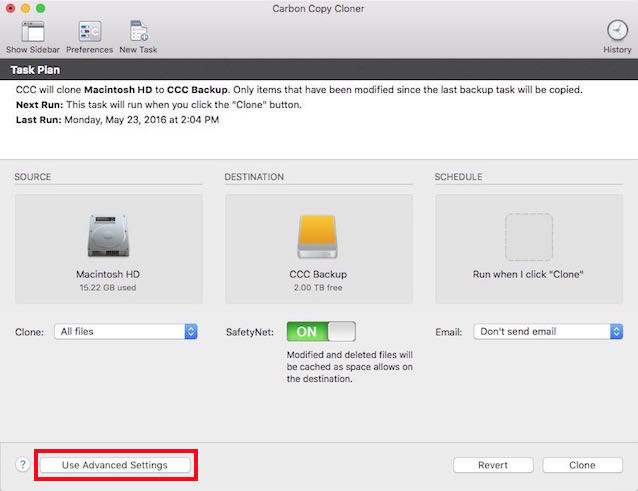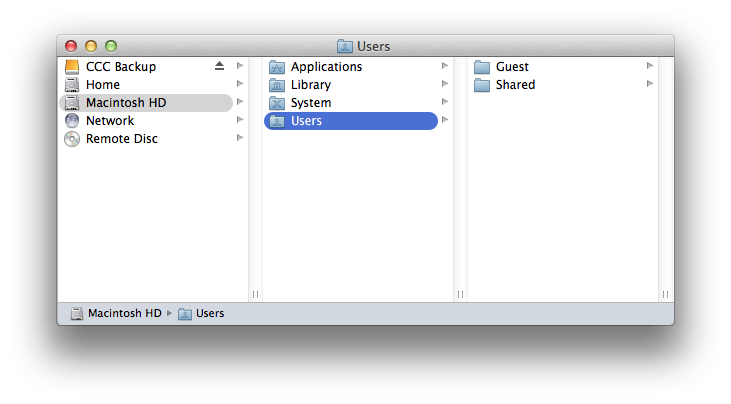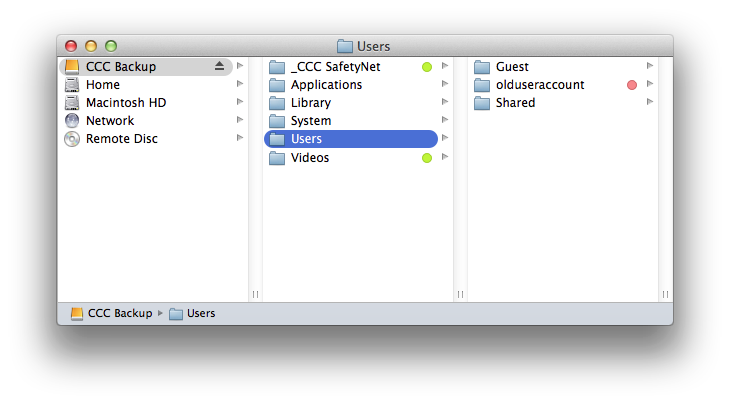CCC's Advanced Settings are helpful in specific situations, but are not generally required for routine use. Some of these settings involve more risk, so please use them with caution, and don't hesitate to ask questions via the Ask a question about CCC... menu item in CCC's Help menu if the explanations below are insufficient for your particular scenario.
To access the advanced settings, simply click on the Use Advanced Settings button at the bottom of the CCC application window. To revert all advanced settings to default values and go back to using simple settings, click the Use Simple Settings button at the bottom of the CCC application window.

Destination Options
Use strict volume identification
By default, CCC uses the name and Universally Unique Identifier (UUID) of your source and destination to positively identify those volumes. By verifying both of these identifiers, there is less risk in, for example, backing up to a volume that has the same name as your usual destination but is not actually the destination.
While beneficial, this behavior can sometimes have the wrong result. For example, if you rotate between a pair of external hard drives, CCC will not backup to both of them even though they have the same name (e.g. Offsite Backup). CCC will instead claim that the UUID of one of the volumes does not match that of the originally chosen destination.
To accommodate a "rotating pair of backup volumes" solution, you can uncheck this option to indicate that CCC should only use the volume name to identify the destination volume. When deselecting this option, be vigilant that you do not rename your destination volume and that you never attach another non-backup volume to your Mac that is named the same as your destination volume.
This option is automatically disabled when the destination volume does not have a UUID. Network volumes and some third-party filesystems, for example, do not have volume UUIDs.
Note: This setting is only applicable to the destination volume. CCC always uses the name and UUID to positively identify the source volume.
Protect root-level items
If you have files and folders on your destination volume that you would like to be left alone, yet you want to keep your backup "clean", use the Protect root-level items option. This option is enabled by default when CCC's SafetyNet option is enabled. To understand how this feature works, suppose you have these items on your source volume:

And you have these items on the destination volume:

With the Protect root-level items option, the Videos folder will not be moved to the _CCC SafetyNet folder because it is unique to the root level of the destination. The Users folder is not unique to the root of the destination, though, so its contents will be updated to match the source. As a result, the olduseraccount folder will be moved to the _CCC SafetyNet folder (or deleted if you have disabled the SafetyNet).
Find and replace corrupted files
CCC normally uses file size and modification date to determine whether a file should be copied. With this option, CCC will calculate an MD5 checksum of every file on the source and every corresponding file on the destination. CCC then uses these MD5 checksums to determine if a file should be copied. This option will increase your backup time, but it will expose any corrupted files within your backup set on the source and destination. This is a reliable method of verifying that the files that have been copied to your destination volume actually match the contents of the files on the source volume.
Media failures occur on nearly every hard drive at some point in the hard drive's life. These errors affect your data randomly, and go undetected until an attempt is made to read data from the failed sector of media. If a file has not been modified since a previous (successful) backup, CCC will not ordinarily attempt to read every byte of that file's content. As a result, it is possible for a corrupted file to go unnoticed on your source or destination volume. Obviously this is a concern if the file is important, and one day you actually need to recover the contents of that file.
Frequent use of the checksum calculation option may be a burden upon your productivity. We do recommend, though, that you add this option to a weekly or monthly backup regimen to verify the integrity of your backup.
Note: CCC will never replace a valid file on your destination with an unreadable, corrupt file from the source. If CCC cannot read a file on your source volume, any existing backup of that file will remain intact on your backup volume and CCC will report an error, advising you to replace the source file with the intact backup version.
What is a "corrupted" or "unreadable" file?
CCC's Find and replace corrupted files option specifically refers to files that cannot be physically read from the disk. It does not refer to files that have been mistakenly or maliciously altered such that they cannot be opened by the application that created them.
Using the "Find and replace corrupted files" option to verify your backup
CCC's checksum option verifies the integrity of the files on your destination volume before files are copied, it is not a verification of files that have just been written. In general, the checksum of a file immediately after it is written to disk is of questionable value. Most disks have a write cache, and file data goes to the cache before it is written to actual media. If you write a file and then immediately ask to read it back, as much as x amount of data (where x = the size of the cache) is going to come from the volatile cache. If any of the file's data comes from the write cache, then the checksum doesn't reflect the status of the data on the permanent media, and that really defeats the purpose of checksumming the file in the first place.
If you want to verify the integrity of the files on your destination, a subsequent backup with CCC's Find and replace corrupted files option is the best way to do that. You can even automate this process by creating a second task that uses this option, then select the second task in the "Run another backup task" popup menu in the After task runs section of advanced settings.
Troubleshooting Options
Run a deletion pass first
When the CCC SafetyNet option is disabled, CCC typically deletes unique items from the destination as it encounters them. CCC iterates through the folders on your source alphabetically, so some files are often copied to the destination before all of the files that will be deleted have been deleted from the destination. If your destination volume has very little free space, CCC may not be able to complete a backup to that volume. This option will cause CCC to run a deletion pass through the entire destination before copying files. Use of this option will make your backup task take longer.
This option will only be enabled when the SafetyNet option is disabled.
Remove excluded files
When you exclude an item from your backup task, CCC will not only avoid that item on your source, but it will also exclude that item from consideration for deletion and archiving on the destination. Suppose, for example, that you have a full backup of your "Media" volume. One day, though, you decide that you really don't need a backup of the "Oldies" folder on this volume, so you exclude Music > Oldies folder from the backup task and disable CCC's SafetyNet option. After running the backup task, you wonder, "Why is Oldies still on the destination?" Oldies isn't unique to the destination, it also exists on the source volume — this is why CCC did not delete that item from the destination. If you were expecting CCC to delete items that you have explicitly excluded from the backup task, this option will provide that functionality.
This option is not applicable if you have selected Don't delete anything SafetyNet setting. This setting also will not override explicit protections placed on the _CCC SafetyNet folder, so when this option is used in conjunction with CCC's "SafetyNet On" setting, items will be moved to the SafetyNet folder rather than deleted immediately.
Also note that this option and the Protect root-level items option work on mutually exclusive sets of files and folders — this option will only affect the items that you have deselected in the Unchecked items will not be copied table (visible when you choose to clone Selected files rather than All files), or excluded via a custom filter, it does not affect items that are unique to the root of the destination. Finally, note that this option is disabled if your destination volume is the startup disk. Use this option with care.
Don't update newer files on the destination
Files on the source are generally considered to be the authoritative master, and CCC will recopy a file if the modification date is at all different — newer or older — on the source and destination. Occasionally there are circumstances where the modification date of files on the destination is altered after a backup task runs (e.g. by anti virus applications), and this alteration causes CCC to copy these files every time. This option can work around these circumstances when the root cause of the modification date alteration cannot be addressed.
Don't preserve permissions
This setting will avoid the errors generated by network volumes that disallow the modification of permissions and ownership on some files. It will also prevent CCC from enabling ownership on the destination volume. Use of this option while backing up applications or macOS system files will prevent those items from working correctly on the destination.
Don't preserve extended attributes
This setting will disable support for reading and writing extended attributes, such as Finder Info, resource forks, and other application-proprietary attributes. Extended attributes store data about the file. Apple explicitly recommends that developers do not store irreplaceable user data in extended attributes when saving a file, because extended attributes are not supported by every filesystem, and could be silently dropped (e.g. by the Finder) when copying a file.
This option is helpful in cases where the source or destination filesystem offers exceptionally poor performance for reading and writing extended attributes, or offers very limited support for macOS native extended attributes such that many errors are reported when trying to copy these metadata.
